RTLS Market for Healthcare Size, Share, Statistics and Industry Growth Analysis Report by Hardware (Tags/Badges, Readers/Trackers), Technology (RFID, Wi-Fi, UWB, BLE, Infrared, Ultrasound, GPS, Zigbee), Application (Inventory/Asset Tracking, Personnel Monitoring), Facility Type, Region - Global Growth Driver and Industry Forecast to 2028
The global RTLS market for healthcare share is predicted to grow from USD 2.0 billion in 2023 to USD 5.8 billion by 2028, at a CAGR of 23.5% during 2023 to 2028.
Healthcare is one of the largest adopters of RTLS solutions. Different wireless technologies, such as Radio-Frequency Identification (RFID), Wireless Fidelity (Wi-Fi), Ultrasound, Infrared (IR), Ultra-Wideband (UWB), and Bluetooth Low Energy (BLE), are being used in modern-day RTLS solutions, depending on the use case or application area. RTLS market players continuously strive to develop more robust and innovative solutions to stay ahead in the competition. As a result, ultra-wideband (UWB) and Bluetooth Low Energy (BLE) technologies have made a mark recently and are expected to witness exponential growth in the near future. Rapidly growing startups are providing various innovative solutions based on relatively new RTLS technologies such as UWB, BLE, ZigBee, and RuBee.
Attractive Opportunities in RTLS market for healthcare:
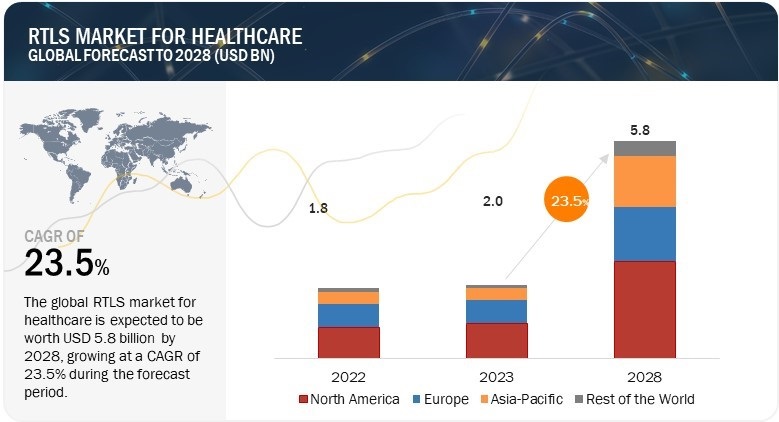
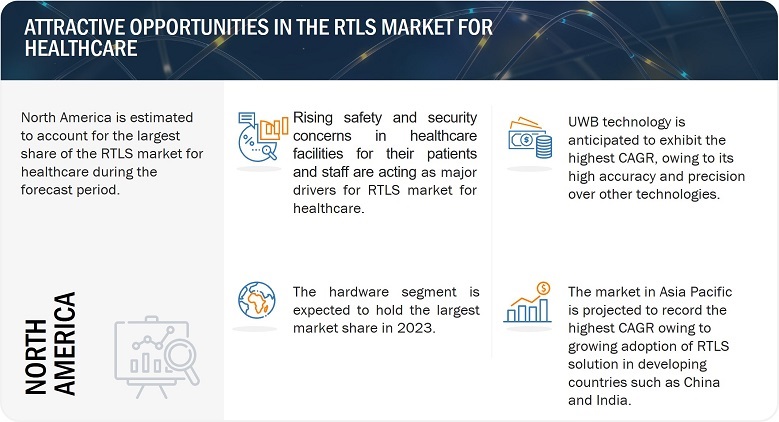
RTLS Market for Healthcare Forecast to 2028
To know about the assumptions considered for the study, Request for Free Sample Report
Market Dynamics
DRIVERS: Rising security and safety concerns of patients/staff
The safety and security of people and assets is the key concern of medical institutions, hospitals, and senior living facilities. Patient tracking, wander management, and access control are becoming some of the essential parameters to be trailed in the hospital environment. RTLS solutions help healthcare organizations increase the safety and security of its staff, patients, and assets by providing real-time information about their location. Advanced RTLS solutions are combined with security systems, such as access control systems and infant protection systems, thereby improving the overall security and protecting infants and patients by restricting unauthorized visitors to enter certain zones. Thus, RTLS solutions witness high demand from the healthcare sector to fulfill the requirement for patient safety and security of electronic health records and valuable assets owing to their capability to safeguard the facility, patients, and personnel.
RESTRAINTS: High installation and maintenance costs
The cost of an RTLS at the time of installation can be very high, ranging in millions depending on the size and type of healthcare facilities and the technology used. For instance, the installation cost of Wi-Fi-based RTLS is less than UWB-enabled systems. The maintenance costs will also vary depending on the specific technologies, such as Wi-Fi, RFID, UWB, and BLE. Many RTLS companies are facing various issues in terms of deployment and technology, as many projects are failing because they require lots of engineering efforts and on-site preferences. In the case of RTLS, the company cannot just ship the hardware and ask the consumer to install—they need to assist customers on the site at the time of installation. The high price of an RTLS is because of the price of hardware, software, technology, infrastructure, wiring, and power. The infrastructure required to run RTLS systems smoothly is expensive, and the wiring, power, installation of RTLS components, etc., also add to the costs. Hence, the high costs involved with installing and maintaining RTLS systems may hamper the market growth during the forecast period .
OPPORTUNITIES: Increasing demand for RTLS solutions in developing countries
The market for RTLS in developing regions such as Asia Pacific, South America and Africa is estimated to grow rapidly owing to the rising customer awareness and huge untapped market opportunities, especially in healthcare, manufacturing, and retail sectors. The acceptance of RTLS solutions in healthcare markets in the Asia Pacific, especially across countries such as Australia, India, China, and other Asia Pacific countries, is growing significantly. The healthcare market in Asia Pacific has witnessed increased adoption of RTLS solutions with Wi-Fi technology as end users utilize the already present infrastructure to drive down installation costs for RTLS. The Asia Pacific healthcare markets are projected to be the significant growth areas for RTLS. The main driving factor would be the rising tide of healthcare-associated infections and increasing focus on developing healthcare infrastructure, which would lead to adopting RTLS solutions in the healthcare market
CHALLENGES: Trade-offs while designing RTLS solutions
RTLS solutions consist of various hardware components such as RTLS tags/badges/readers etc. These equipment are used across healthcare organizations to monitor and track assets, patients, and staff. These tags are supposed to meet some crucial parameters in terms of accuracy, performance, and power consumption, to meet specific customer requirements. However, any one solution can not fufill all the performance standards, and manufacturers need to make tradeoffs to meet requirements of specific applications such as asset tracking or personnel monitoring. For instance, narrowband tags may not offer highest accuracy whereas wideband tags may offer accuracy but lack in other aspects such as power consumption. Hence, it is difficult to develop one solution that could fulfill all requirements and such challenges in designing a perfect RTLS solution may act as a challenge for this market’s growth.
Services segment is expected to grow with the highest CAGR during the forecast period.
In RTLS market for healthcare, the services segment mainly comprises consulting, support and maintenance, and deployment and integration services necessary for the successful operation of an RTLS solution. These services help to deliver and implement solutions at customer sites and also look after the maintenance after the solution has been implemented. Services are a critical part of the overall RTLS implementation, which can affect the budget of an enterprise in a significant manner if ignored. The services segment is expected to witness the highest growth in the RTLS market for healthcare size, among other offerings. The cost of services includes installation and regular maintenance costs, which would result in higher expenditure. The demand for consulting services is likely to increase rapidly as consultation is the most critical parameter, which helps in deciding the type and scale of an RTLS solution required for the specific use case.
The market for UWB technology is projected to grow at highest CAGR during the forecast period.
In the RTLS market for healthcare, UWB is one of the most dynamic and fastest-growing technologies, and the UWB technology-based RTLS industry for healthcare has huge potential for growth during the forecast period. This technology functions similarly to active RFID, wherein the tag is continuously sending out RF energy into the environment for receivers to pick up. UWB-based RTLS solutions operate in a large bandwidth spectrum. In larger environments with many tags, receivers are placed at larger intervals with sub-receivers in between to improve accuracy. The signals from the tags are extremely short and obtain the unique ID of the tag. UWB is highly accurate on a room-level and zone-level basis and can calculate the location within a few centimeters due to its short, narrow transmissions. The increasing popularity of UWB is mainly due to advantages such as high precision, long battery life, high capacity, and fast update rates. These advantages of UWB solutions make them ideal for high-precision applications in healthcare organizations or facilities.
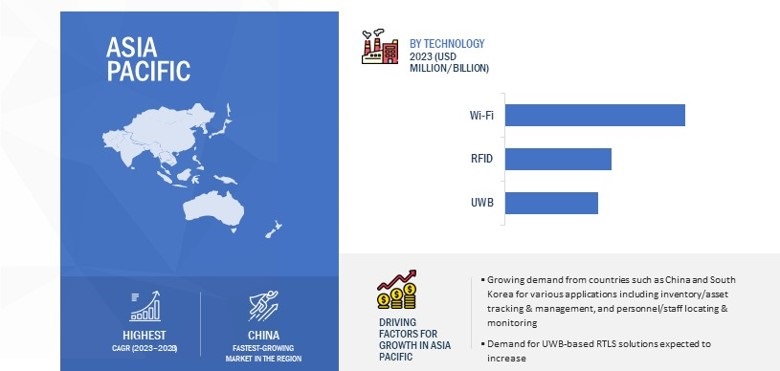
RTLS Market Statistics for Healthcare by Region
To know about the assumptions considered for the study, download the pdf brochure
The market in Asia Pacific is projected to grow at the highest CAGR from 2023 to 2028.
Asia Pacific is one of the key future potential markets for RTLS solutions. The market in this region is expected to exhibit the highest CAGR during the forecast period. Asia Pacific is witnessing advancements in the healthcare sector as several healthcare facilities adopt newer technology-based products to improve their performance and automate certain processes. Japan is the early adopter of RTLS in this region and has witnessed the highest growth in the RTLS market for healthcare. Countries such as South Korea, China, and Australia are now expected to witness high growth in the RTLS market for healthcare. The growing healthcare sector of China is expected to be the driving factor for the development of the RTLS market for healthcare in China. The RTLS industry growth of the market is mainly driven by the adoption of Wi-Fi and RFID technology-based RTLS solutions for several applications, such as asset tracking, patient tracking, hand hygiene tracking, environmental monitoring, and vehicle tracking in hospitals and healthcare facilities.
Key Market Players
Securitas Healthcare, LLC (US), Zebra Technologies Corporation (US), Aruba Networks (US), Impinj, Inc. (US), Savi Technology (US), TeleTracking Technologies, Inc. (US), CenTrak, Inc. (US), Advantech Co., Ltd. (Taiwan), Ubisense Ltd. (UK), and GE HealthCare Technologies Inc. (US) are the RTLS companies for healthcare among the key players.
Get online access to the report on the World's First Market Intelligence Cloud
- Easy to Download Historical Data & Forecast Numbers
- Company Analysis Dashboard for high growth potential opportunities
- Research Analyst Access for customization & queries
- Competitor Analysis with Interactive dashboard
- Latest News, Updates & Trend analysis
Request Sample Scope of the Report
Get online access to the report on the World's First Market Intelligence Cloud
- Easy to Download Historical Data & Forecast Numbers
- Company Analysis Dashboard for high growth potential opportunities
- Research Analyst Access for customization & queries
- Competitor Analysis with Interactive dashboard
- Latest News, Updates & Trend analysis
|
Segment |
Subsegment |
| Estimated Market Size | USD 2.0 Billion |
| Projected Market Size | USD 5.8 Billion |
| Growth Rate | 23.5% |
|
Market Size Available for Years |
2019–2028 |
|
Base Year |
2022 |
|
Forecast Period |
2023–2028 |
|
Units |
Value (USD Million/Billion) |
|
Segments Covered |
Offering, Technology, Application, and Facility Type |
|
Geographic Regions Covered |
North America, Asia Pacific, Europe, and RoW |
|
Companies Covered |
Major Players: Securitas Healthcare, LLC (US), Zebra Technologies Corporation (US), Aruba Networks (US), Impinj, Inc.(US), Savi Technology (US), TeleTracking Technologies, Inc. (US), CenTrak, Inc. (US), Advantech Co., Ltd. (Taiwan), GE HealthCare Technologies Inc. (US), Ubisense Ltd. (UK), Alien Technology, LLC (US), Cerner Corporation (US), AiRISTA Flow, Inc. (US), Sonitor Technologies (US), and Midmark Corporation (US), and Others- (Total 28 players have been covered) |
RTLS Market for Healthcare Highlights
This research report categorizes the RTLS market for healthcare by offering, technology, application, facility type and region.
|
Segment |
Subsegment |
|
By Offering: |
|
|
By Technology: |
|
|
By Application: |
|
|
By Facility Type: |
|
|
By Region |
|
Recent Developments
- 30th Oct 2023, Enlighted has announced new AI capabilities for its Location Services RTLS solution, which now provides over 98% accuracy in tracking asset and personnel badge location. This solution is particularly useful in healthcare and manufacturing, where understanding the exact location of assets is essential. Enlighted has also partnered with Tagnos and Zan Compute to use its RTLS location data for patient care and asset tracking in hospitals and to guide necessary cleaning activity in smart buildings.
- 16th Oct 2023, To comply with the new mandatory care minutes in Australia's aged care sector, real-time location systems (RTLS) and location-based services (LBS) have become essential. The new policy requires a minimum care minutes responsibility linked to a casemix-adjusted funding model, such as the Australian National Aged Care Classification (AN-ACC). The initial 200-minute daily care target has been mandated for all residential aged care facilities, with a plan to increase to a sector-wide average of 215 minutes daily (including 44 minutes of RN time) from October 1, 2024. RTLS and LBS solutions can automate and track care activities, ensuring the precise recording and reporting of care minutes, empowering operators to optimize staffing levels and allocate resources judiciously, thereby enhancing resident care and ensuring strict compliance with government mandates.
- 18th Oct 2023, Rapyuta Robotics and Sumitomo Corporation of Americas have partnered to provide a combined PA-AMR and UWB RTLS solution for warehouses. This solution will improve item/SKU seeking time, picking accuracy, and safety in the workplace. UWB RTLS provides insights on the exact routes and stops taken by PA-AMRs, which can be used to improve processes further. The two companies will jointly exhibit their innovative technology solutions at the National Retail Federation conference and expo in January 2024.
- 10th Oct 2023, Vizzia Technologies, a leading provider of RTLS for healthcare, has been selected by a nationally recognized health network to track thousands of specialty medical devices, monitor hand hygiene, and generate real-time data analytics to improve healthcare efficiencies and patient care.
- 6th Sept 2023, Zebra Technologies has partnered with the Minnesota Vikings to apply its RFID tracking technology to capture player and ball data for each of the Vikings' practice sessions this season. The Zebra MotionWorks Sport system uses RFID tags to transmit real-time location system (RTLS) data to receivers positioned around stadiums and practice facilities, providing live outputs during procedures to track player progress and workloads in real-time. The technology captures metrics such as player speed, distance traveled per play, and ball orientation.
- 11th August 2023, InnerSpace, a SaaS-based space utilization platform, raised $10M CAD in Series A funding to accelerate product development and scale operations. InnerSpace's proprietary Wi-Fi-based RTLS enables accurate data on how employees are using the office, such as how often they come, how long they stay, patterns of movement, and resources used. Real estate and workplace experience teams use this data to optimize team placement, meeting room needs, and overall square footage requirements.
- 25th July 2023, CYBRA Corporation announced their RFID-based tracking solution for the health and sciences industry, highlighting its value for inventory control. Thermo Fisher uses CYBRA's Edgefinity IoT® RFID Solution to track the processing and transport of serum in quarantine, ensuring meticulous monitoring and rapid response to disruptions. Edgefinity IoT® is a platform for building integrated applications that locate and help protect people, assets, and vehicles using RFID, RTLS, and other sensor technologies. Thermo Fisher can now track the movement and status of inventory in real time, with all location data stored within Edgefinity IoT for audit purposes.
Frequently Asked Questions (FAQ):
What is the total CAGR expected to be recorded for the RTLS market for healthcare during 2023-2028?
The global RTLS market for healthcare is expected to record a CAGR of 23.5% from 2023–2028.
What are the driving factors for the RTLS market for healthcare?
Rising availability of cost-effective RTLS solutions, high return on investment (RoI) with reduced capital capital expenditure, and high accuracy of UWB-based RTLS solutions are some of the key driving factors for this market.
Which application will grow at a fast rate in the future?
Supply chain management and automation application is expected to grow at the highest CAGR during the forecast period. RTLS in supply chain management plays a major role in enhancing supply chain visibility across healthcare organizations by precisely locating equipment and personnel.
Which are the significant players operating in the RTLS market for healthcare?
Securitas Healthcare, LLC (US), Zebra Technologies Corporation (US), Aruba Networks (US), Impinj, Inc. (US), Savi Technology (US), TeleTracking Technologies, Inc. (US), CenTrak, Inc. (US), Advantech Co., Ltd. (Taiwan), Ubisense Ltd. (UK), and GE HealthCare Technologies Inc. (US) are among a few key players in the RTLS market for healthcare.
Which region will grow at a fast rate in the future?
The RTLS market for healthcare in Asia pacific is expected to grow at the highest CAGR during the forecast period. China holds immense potential for the growth of the healthcare and IoT industries. This growth is attributed to various factors, such as government funding to promote IoT and other advanced technologies such as UWB, AI etc. in healthcare sector and the emergence of smart infrastructure.
To speak to our analyst for a discussion on the above findings, click Speak to Analyst
The study involved four major activities in estimating the current size of the real-time location system (RTLS) market for healthcare. Exhaustive secondary research has been done to collect information on the market, peer market, and parent market. To validate these findings, assumptions, and sizing with industry experts across the value chain through primary research has been the next step. Both top-down and bottom-up approaches have been employed to estimate the complete market size. After that, market breakdown and data triangulation methods have been used to estimate the market size of segments and subsegments. Two sources of information-secondary and primary-have been used to identify and collect information for an extensive technical and commercial study of the RTLS market for healthcare.
Secondary Research
Secondary sources include company websites, magazines, industry news, associations, and databases (Factiva and Bloomberg). These secondary sources include annual reports, press releases, and investor presentations of companies, white papers, certified publications, articles by recognized authors, regulatory bodies, trade directories, and databases.
Various secondary sources include corporate filings such as annual reports, investor presentations, and financial statements, trade, business and professional associations, white papers, manufacturing associations, and more.
Primary Research
Primary sources mainly consist of several experts from the core and related industries, along with preferred RTLS providers, distributors, alliances, standards, and certification organizations related to various segments of this industry’s value chain.
In the primary research process, various primary sources from both supply and demand sides were interviewed to obtain qualitative and quantitative information on the market. The primary sources from the supply-side included various industry experts such as Chief Experience Officers (CXOs), Vice Presidents (VPs), and Directors from business development, marketing, product development/innovation teams, and related key executives from RTLS providers, such as Securitas Healthcare, LLC (US), Zebra Technologies Corporation (US), and Aruba Networks (US); research organizations, distributors, industry associations, and key opinion leaders. Following is the breakdown of primary respondents.
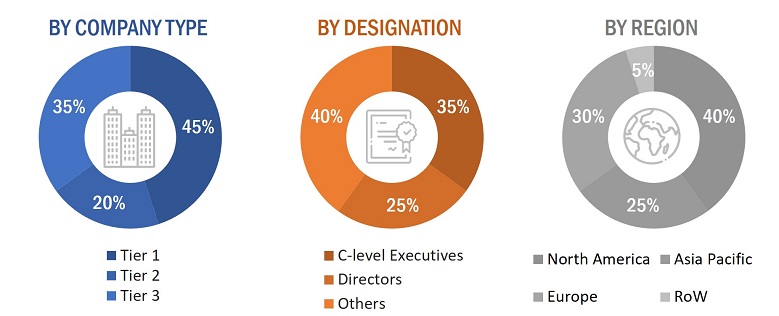
To know about the assumptions considered for the study, download the pdf brochure
Market Size Estimation
Both top-down and bottom-up approaches have been used to estimate and validate the total size of the RTLS market for healthcare. These methods have also been used extensively to estimate the size of various subsegments in the market. The following research methodology has been used to estimate the market size:
- Major players in the industry and markets have been identified through extensive secondary research.
- The industry’s value chain and market size (in terms of value) have been determined through primary and secondary research processes.
- All percentage shares, splits, and breakdowns have been determined using secondary sources and verified through primary sources.
Data Triangulation
After arriving at the overall market size from the estimation process explained above, the overall market has been split into several segments and subsegments. The market breakdown and data triangulation procedures have been employed, wherever applicable, to complete the overall market engineering process and arrive at the exact statistics for all segments and subsegments. The data has been triangulated by studying various factors and trends from both the demand and supply sides. The market has also been validated using both top-down and bottom-up approaches.
Market Definition
Real-time location systems (RTLS) are local positioning and tracking systems used to locate and identify objects/people/targets automatically in real time, usually for indoor applications such as within buildings or other contained areas. RTLS tags/badges/sensors attached to objects or worn by people communicate wirelessly with readers/trackers/access points installed in the vicinity.
An RTLS solution may use different technologies for communication between tags and receivers, depending on the application/use case requirement. Various technologies, such as Radio-Frequency Identification (RFID), Wireless Fidelity (Wi-Fi), Ultrasound, Infrared, Ultra-Wideband (UWB), and Bluetooth Low Energy (BLE), are used for precise locating or tracking applications in real time. The RTLS ecosystem includes various hardware, software, and service providers. RTLS solutions are being used in the healthcare industry for various applications such as inventory/asset tracking & management, personnel/staff locating & monitoring, access control/security, and environmental monitoring. RTLS solutions also include data analysis tools and representation interfaces for controlling and monitoring objects or people.
Key Stakeholders
- Raw Material Suppliers
- Component Designers, Manufacturers, and Suppliers
- Original Equipment Manufacturers (OEMs)
- System Integrators
- Technology, Service, and Solution Providers
- Testing, Inspection, and Certification Companies
- Suppliers and Distributors
- Government and Other Regulatory Bodies
- Industry Forums, Alliances, and Associations
- Research Institutes and Organizations
- Market Research and Consulting Firms
- End Users
Report Objectives
- To define and forecast the RTLS market for healthcare in terms of offering, technology, application, and facility type.
- To describe and forecast the RTLS market for healthcare and its segments for four regions—North America, Europe, Asia Pacific, and the Rest of the World (RoW), along with their respective countries.
- To provide detailed information regarding the drivers, restraints, opportunities, and challenges influencing the growth of the market
- To strategically analyze micromarkets with respect to individual growth trends, prospects, and contributions to the overall market
- To study the complete value chain and allied industry segments of the RTLS market for healthcare
- To analyze opportunities in the market for stakeholders by identifying high-growth segments of the market
- To strategically profile key players and comprehensively analyze their market position in terms of ranking and core competencies, along with a detailed market competitive landscape.
- To analyze strategic approaches such as agreements, collaborations, and partnerships in the RTLS market for healthcare
- To provide an analysis of the recession impact on the growth of the market and its segments
Available Customizations:
Based on the given market data, MarketsandMarkets offers customizations in the reports according to the client’s specific requirements. The available customization options are as follows:
Company Information
- Detailed analysis and profiling of additional market players (up to 5)


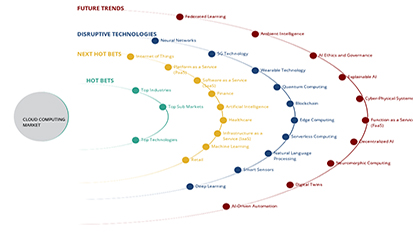

 Generating Response ...
Generating Response ...







Growth opportunities and latent adjacency in RTLS Market
Many vendors in RTLS market are combining two or more technologies for making their RTLS system more efficient, for example BLE technology is being combined with Wi-Fi. I would like to in the report the RTLS hybrid technologies are covered under which segment?
We corporate with the Taiwan government “The New Southbound Policy”. So we are seeing if there have possible business opportunities in South Asia countries.Usually, we ask for help from the office of trade negotiations. They will give Taiwan local companies business information on the interesting areas.For the covid-19 pandemic, Avalue’s Renity RTLS solution is suitable for Hospital’s asset tracking and management. That’s why I am looking for “RTLS Market for Healthcare”. I am collecting all kinds of information about Healthcare solutions for South Asia countries.
The hospitals and healthcare facilities are the major demand generators for RTLS. I want to gets insights on this segment. Is the market sizing on hospitals by number of beds covered in the report?
Increased market competitiveness with the emergence of startups providing innovative and customized RTLS solutions based on newer technologies is a major factor fueling the growth of RTLS market for healthcare. We are also interested in entering in this market so would like to get information on the leading players. What parameters were used to rank the players?
RFID and Wi-Fi are the prominent technologies in the RTLS market for healthcare, while UWB and BLE are the emerging ones. We want to explore the market for UWB and BLE technologies and thus want to learn more about these technologies.
Senior living spaces are the emerging application area for RTLS systems. We want to understand opportunities which this segment holds. Let us know if the report includes data on senior living spaces by hardware, technology, and region.